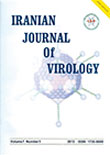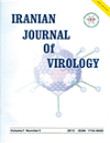فهرست مطالب

Iranian Journal of Virology
Volume:8 Issue: 1, 2014
- تاریخ انتشار: 1393/04/07
- تعداد عناوین: 6
-
-
Pages 1-6Background And AimsHIV is spreading rapidly among people word wide. Infection with this virus leads to immune suppression and finally acquired immune deficiency syndrome (AIDS).Early HIV detection is depended on antibody screening against virus by Enzyme Linked Immunosorbent Assay (ELISA).Some confirmatory tests such as; Western Blot and Recombinant Immunobloting Assay (RIBA), are used to verify viral infection. Many of confirmatory tests results are indeterminate. The aim of this study is comparing the frequency and patterns of indeterminate results in two groups; blood donors and patients with high risk behaviors, in northeast of Iran.Materials And MethodsFrom October 2009 to March 2014 total number of 1055 serum samples with previous positive HIV ELISA test history, were tested in our laboratory. Some by RIBA and some by western blot method.ResultsMost of indeterminate results belonged to blood donors that were tested by Western Blot analysis and were positive. The most reacting band was P24 in both methods and groups.ConclusionRIBA assay is more sensitive and reliable than western Blot; but it’s necessary to use other supplementary tests with less indistinctive results.Keywords: Western blot, RIBA, HIV, Indeterminate
-
Pages 7-12Background And AimsCertification programs of plant propagating materials rely on faster, cheaper and more importantly sensitive and reliable methods for detection of systemic pathogens as indicated in national and/or international health standards of plant propagating materials. Reverse transcription-polymerase chain reaction (RT-PCR) has been documented as an alternative assay for certification of plant propagating materials. RT-PCR has been shown to be necessary for olive certification due to the inefficiency of other methods in detecting viruses. The object of the present study was the optimization of a multiplex RT-PCR assay for simultaneous detection of Arabis mosaic virus (ArMV), Cherry leafroll virus (CLRV) and Cucumber mosaic virus (CMV) together with the plant mRNA as internal control for olive certification programs in Iran.Materials And MethodsTotal RNA was extracted from olive tissues infected by ArMV, CLRV and CMV as well as from healthy plants and subjected to cDNA synthesis by M-MuLV reverse transcriptase. Simplex, duplex and multiplex RT-PCR (s-, d-, and mRT-PCR) were optimized for amplification of target genes. Amplified fragments were further sequenced for evaluation of the accuracy of the assays.ResultsGenomic fragments of ArMV, CLRV, CMV and the plant internal control (Nad 5 gene) were successfully amplified in all assays. The sequence information as well as application of the developed method on samples derived from different origins revealed the accuracy of all assays in olive certification schemes.ConclusionResults from the developed s-, d-, and mRT-PCR assays revealed RT-PCR as an excellent assay for olive certification. Moreover, coamplification of Nad5 gene fragment suggested that was a robust marker for analyzing the accuracy of the developed RT-PCR as shown previously in other crops as well.Keywords: Multiplex RT, PCR, Nad5, Virus detection, Olive
-
Pages 13-18Background And AimsRotaviruses are the main cause of gastroenteritis in the young of human and a variety of animals in the world. Rotavirus G6 and G10 are the most prevalent genotypes in cattle worldwide, but are also found in human with possible origination from animals.Materials And MethodsIn this work, we have detected the G6 and G10 genotypes of bovine rotaviruses isolated from diarrheic calves in Tehran province by RT-PCR. The amplified VP7 genes were cloned, sequenced and compared to the sequences deposited in the GenBank database from the world.ResultsThe phylogenetic analysis showed that the Iranian G6 and G10 genotypes are most identical to the genotypes from Ireland (>98.6% amino acid homology) and Canada (>97.3% amino acid homology), respectively.ConclusionThis high similarity between the Iranian sequences and those from the far countries may suggest that the virus can be spread in a wide geographic region possibly by animal transportation.Keywords: Bovine rotaviruses, VP7 molecular analysis, Iran
-
Pages 19-24Background And AimsNewcastle disease virus (NDV) is an avian paramyxovirus (A-PMV 1) and one of the major pathogens in poultries. Vaccination is intended to control the disease, nevertheless this virus is a growing threat to the poultry industry. So, early detection of the virus can prevent the spread of illness and avoid huge economic losses. Towards this goal, in this research, we developed two novel in-house one-step rRT-PCR assays; based on SYBR Green and specific TaqMan probe for accurate and rapid molecular identification of Newcastle disease virus.Materials And MethodsIn this experimental study, after preparation of viral sample, respective RNA was extracted from virus by using viral RNA extraction kit. The specific probe and primers were designed, based on the conserved region of matrix (M) protein encoding gene of NDV, and used to produce c-DNA and subsequently to amplify and detect this region by two novel one-step real-time reverse-transcription polymerase chain reaction (rRT-PCR) assays. These diagnostic appraisements were carried out using SYBR Green and matrix (M) gene specific TaqMan probe.ResultsThe presence of M gene in RNAs, extracted from NDV samples, was confirmed by both of these one-step rRT-PCR assays and the results of these diagnostic tests were positive.ConclusionThis study showed that these two developed one-step rRT-PCR assays are the proper molecular methods for rapid and accurate diagnosis of NDV by detection of matrix (M) protein encoding gene.Keywords: Matrix (M) gene, Newcastle Disease Virus (NDV), One, step rRT, PCR, Rapid diagnosis, SYBR Green, TaqMan probe
-
Pages 25-32Background And AimsIn spite of a long tradition of fruit-tree growing in all provinces of Iran, information on pear (Pyrus communis) tree viruses is scant. In order to identify of the nature of the virus like symptoms and decline in pear trees, we carried out a survey for the occurrence of four important viruses.Materials And MethodsLeaf samples of pear showing virus like symptoms were collected in three provinces, Iran, in 2013 and 2014 and tested for Apple chlorotic leaf spot (ACLSV), Apple stem pitting virus (ASPV), Apple stem grooving virus (ASGV) and Tomato ring spot (ToRSV) infection by ELISA, using specific antibodies.Results39 out of 112 leaf samples were found to be infected by at least ToRSV and ACLSV. ToRSV was detected in the symptomatic samples from all surveyed provinces with infection ranging from 32.4% up to 35.0%; however, the infection of ACLSV was differed between 9.9 to 18.2 %. Infections of ELISA positive samples were confirmed by biological assay. DNA fragments of 580 and 700 bp in size were RT-PCR amplified using specific primers designed according to RdRp and CP genes of ToRSV and ACLSV, respectively which indicated 96 and 92 % highest identities with available sequences of ToRSV and ACLSV isolates in GenBank, respectively.ConclusionThis analysis provides, to our knowledge, the first demonstration of pear trees infection with ACLSV and ToRSV in Iran. Early detection of viral pathogens and accurate diagnosis, are undoubtedly essential for controlling the spread of virus and ensuring production of healthy plant reproductive material for further cultivation.Keywords: Detection, ACLSV, ToRSV, RT, PCR
-
Pages 33-34Sweet lime split bark is a disorder of increasing importance in Fars province. Previously we showed that a new variant of hop stunt viroid (HSVd-sb) was related to the disorder. It had homology with a noncachexia variant of hop stunt viroid (CVd-IIa-117) which causes cracking the bark of trifoliate orange rootstocks. In this study, showed that M.NgoBIX, BglI and BsrI restriction enzymes can cut HSVd-sb according to putative RFLP analysis using Vector NTI program (version 9.0.0) database but these restriction enzymes can’t cut CVd-IIa-117. In other hand some restriction enzymes can cut CVd-IIa-117 but can’t cut HSVd-sb. Therefore these two variants can be recognized by these restriction enzymes.Keywords: HSVd, sb, CVd, IIa, 117, Restriction Fragment Length Polymorphism analysis


